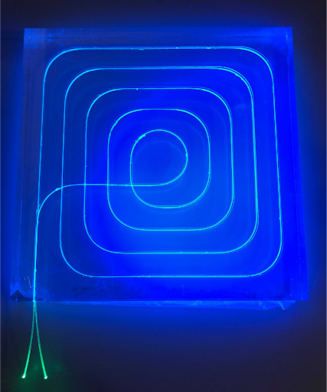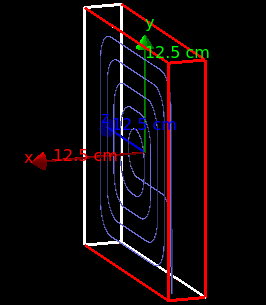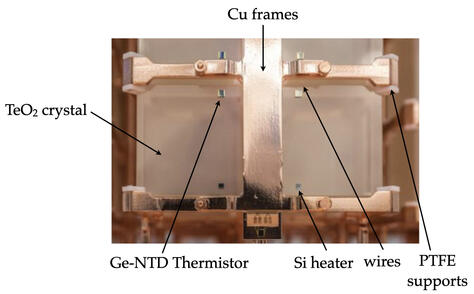Research Activities
The CUORE/CUPID group at Yale is involved in several projects in CUORE and CUPID. In the past, the group was involved in the design, construction, and commissioning of the CUORE cryostat, and in the analysis and simulation of CUORE and CUORE-0 data. We are currently involved in CUORE analyses and seismometer studies. The group is also leading research and development projects for CUPID, the successor to CUORE. Our ongoing research projects are described below.
CUPID Research Activities
CUPID Muon Veto SystemCUORE is located 1400 m underground in Hall A of LNGS, which provides a 3600 meter water equivalent (m.w.e) overburden of rock. With this shielding, there is a muon flux of ~2 muons/hour in the crystals and ~7 muons/hour in the lead shielding. These events contribute backgrounds to the experiment, and CUORE does not currently have dedicated hardware for detecting muon induced events. Moving to CUPID, muons will become the most significant background after the planned upgrades if no muon tagging system is added. A reduction of at least 99% in the muon background is needed to achieve the significant increases in sensitivity for CUPID. The CUORE Group at Yale is leading the research, design, and implementation of a muon tagging system that will be tested in CUORE and fully implemented for CUPID. CUPID Muon Veto: Hardware Research and Development
Our group is currently performing R&D for a muon tagging system consisting of a modular design of plastic scintillating panels with embedded wavelength shifting scintillating fiber, that are readout by Silicon Photomultiplier (SiPM) detectors. The CUORE cryostat has limited space and tight space constraints around the system. The muon tagger is being designed to be highly compact and fit into the tight space constraints around the CUORE and CUPID cryostat while achieving the required rejection >99% efficiency. Pictured: A prototype of a single panel for the CUORE/CUPID muon veto system illuminated under UV light (Photo Credit: S.Pagan) Rendering of possible mu
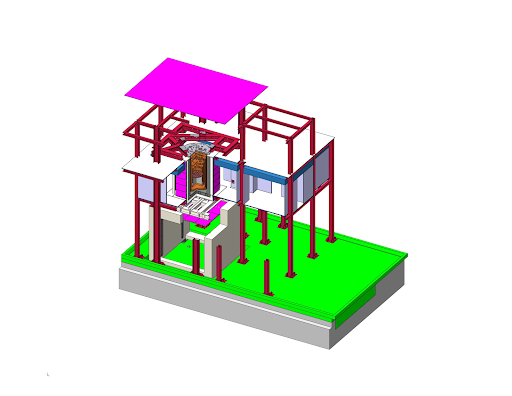 on veto panels around the CUPID Cryostat and Hut(Photo Credit: J. Wilhelmi) on veto panels around the CUPID Cryostat and Hut(Photo Credit: J. Wilhelmi) |
CUPID Muon Veto: SimulationsIn addition to the hardware R&D for the muon veto system, our group is studying this system with simulations. Questions such as the geometric coverage of the panels, the light collection of single-panel designs, and the overall system efficiency can be studied through simulations. With these studies, we aim to understand the efficiency of varying configurations and optimize the design of the CUPID muon tagger.
|
CUPID Muon Veto: Data Acquisition System and IntegrationOur group is in charge of designi We have decided to use the DT5202 board from CAEN, which has the advantage of being designed for experiments with large arrays of SiPM channels, and provides bias to the SiPMs. We are currently testing the system at Wright Lab, and adapting the DAQ software to meet our needs. |
CUPID Detector Research: NTD Thermistors
CUORE’s next-generation experiment, CUPID will operate on a similar principle to CUORE, monitoring temperature fluctuations in crystals of molybdenum to search for neutrinoless double beta decays. Each crystal and light detector will have a thermistor attached made of neutron-transmutation-doped germanium to monitor its temperature. Our group is responsible for optimizing NTD production by determining the level of irradiation for doping the germanium to the desired dopant concentration. For this, we are studying the performance of the NTDs in CUORE, as well as related experiments. |
CUORE Research ActivitiesCUORE Detector Response: Seismometer Studies
The CUORE detector is designed to be extremely sensitive to temperature in order to detect temperature fluctuations arising from deposited energy from particles passing through the CUORE crystals. As a result, even small vibrations of a crystal that create thermal noise are detectable in our experiment, and a large source of noise for CUORE is seismic activity. In our group, we study the response of the detector to seismic activity using the seismometric system installed in the CUORE hut in Gran Sasso. Pictured above: Earthquakes and aftershocks cause heating in the CUORE detector, which interferes with data collection. The CUORE detector is also sensitive to other seismic activity, including smaller amplitude activity over longer periods, which degrades the energy resolution of the detector. |
CUORE Analysis: Low Energy AnalysisIn addition to studying neutrinoless double decay, CUORE can search for rare events such as dark matter and other beyond the standard model particles. Weakly Interacting Massive Particles (WIPMs) and Solar Axion searches are two different types of dark matter searches that could be performed with CUORE. Some of these searches would occur below 100 keV, a lower energy than the ~2,527.5 keV energy signal of neutrinoless double decay.The development of additional low-energy techniques is required for these kinds of searches. Our group is involved in developing methods for performing low energy analyses in CUORE and pursuing a search for solar axions. |
CUORE Analysis: Jitter ProjectsThe CUORE detector is an array of 988 bolometers or channels, arranged into 19 towers. Some events deposit energy in only one bolometer, but many events deposit energy in multiple bolometers. Events that happen simultaneously in CUORE are called coincidence events. Because CUORE is made of many bolometers with varying crystal response, there is a time delay seen in different channels called jitter. The CUORE analysis uses multiple methods to account for jitter, including correcting jitter from coincidence events between towers and using a pulse shape analysis variable as a proxy for jitter. Our group is working to develop and validate two new algorithms of calculating jitter. The first methods would calculate jitter between each channel in CUORE to create a matrix of jitter values. The second algorithm adds the energy dependence of events into the jitter calculation. The goal of both methods is to improve the timing resolution between coincident events in CUORE. Pictured below: The array of 988 bolometers that make up the CUORE detector.
 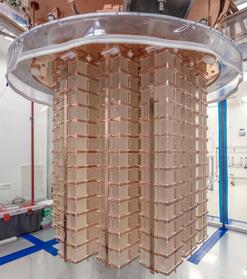 |
CUORE Analysis: Efficiency Calculations for 1 Tonne Year of Data
This most recent CUORE analysis of 0vbb in Te-130 consisted of 15 datasets and a TeO$_2$ exposure of 1038.4 kg · yr. Achieving an analysis of one tonne-year of data demonstrated the reliability of CUORE and the feasibility of scaling. This analysis found no evidence for 0νββ decay, and a lower bound of T 0ν 1/2 > 2.2 × 1025 yr at a 90% credibility interval was set for 0vbb in Te-130. Our group calculated the analysis efficiency for these results, which included the reconstruction, anticoincidence, and the Pulse Shape Discrimination (PSD) efficiencies. Reconstruction efficiencies are calculated from “pulsers,” which are thermal injections to the CUORE detector. Pulsers have a known energy and a signal-like shape that allows the efficiencies to be calculated on these events. The reconstruction efficiencies combine the efficiency that a signal is triggered, does not occur in the same event window as another event, and that the signal energy is properly reconstructed. Efficiencies are calculated for each channel in every dataset. The overall exposure-weighted average of the pulser reconstruction efficiencies was 96.418 +/- .002 %. Further in the analysis chain, we apply two other cuts to the data. (1) We apply an anticoincidence cut. We expect the majority of neutrinoless double-beta decay events to deposit all of its energy in a single crystal, so we cut out events in which energy is deposited in more than one channel. (2) After applying an anticoincidence cut, we apply a pulse shape discrimination cut. We cut out events with pulse shapes that are very different to an average pulse shape, as determined by a principal component analysis. |
Past ActivitiesCUORE Detector Calibration SystemThe Detector Calibration System (DCS) is a system of motors, linear actuators, thermalization mechanisms, and other hardware that guides calibration sources into the CUORE cryostat (shown on right) and extracts them after calibration periods have concluded. Our group designed and installed the DCS in the CUORE cryostat. As the DCS is integrated into a dilution refrigerator, there were several strict requirements on its construction and operation. One primary consideration was that the source strings and guide tubes had to be designed to minimize thermal conductivity between the various stages of the cryostat. In addition, there could not be any straight-line access between the different regions of the cryostat to avoid thermal radiation warming up colder stages. During string motion, frictional heating, which can be particularly pronounced at the coldest stages of the cryostat, had to be minimized. Additionally, during string lowering, the source strings needed to be designed to be cooled as they were lowered in order to avoid dumping large amounts of heat into the colder parts of the cryostat and affecting the detector operation. |

CUORE and CUORE-0 calibration analysis and simulationOur group has helped to develop the analysis framework for the CUORE and CUORE-0 experiments and has performed simulations for determining the optimal calibration source design, activity, and positioning in the CUORE and CUORE-0 cryostat. |

CUPID R&D and CUORE muon trackerThe CUORE cryostat does not have dedicated hardware for detecting incoming muons. Although the experiment is located deep underground, the muon flux is not negligible. The CUORE analysis stools can detect many muon events, but a dedicated piece of hardware for detecting muons can significantly improve upon this detection efficiency. A dedicated muon tracker can also validate and help us refine simulations that predict the muon cut efficiency using the existing detectors alone. Moreover, a reduction in the muon background is required to achieve the significant increases in sensitivity required for CUPID, the successor to the CUORE experiment. |
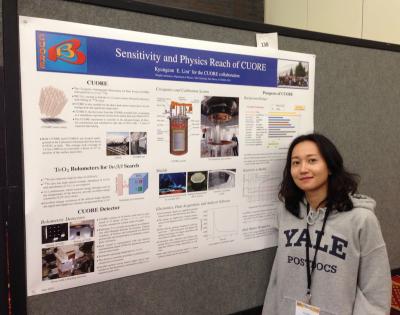
Responsibilities and ManagementThe CUORE group at Yale maintains several active leadership positions inside the CUORE Collaboration. These include:
|
